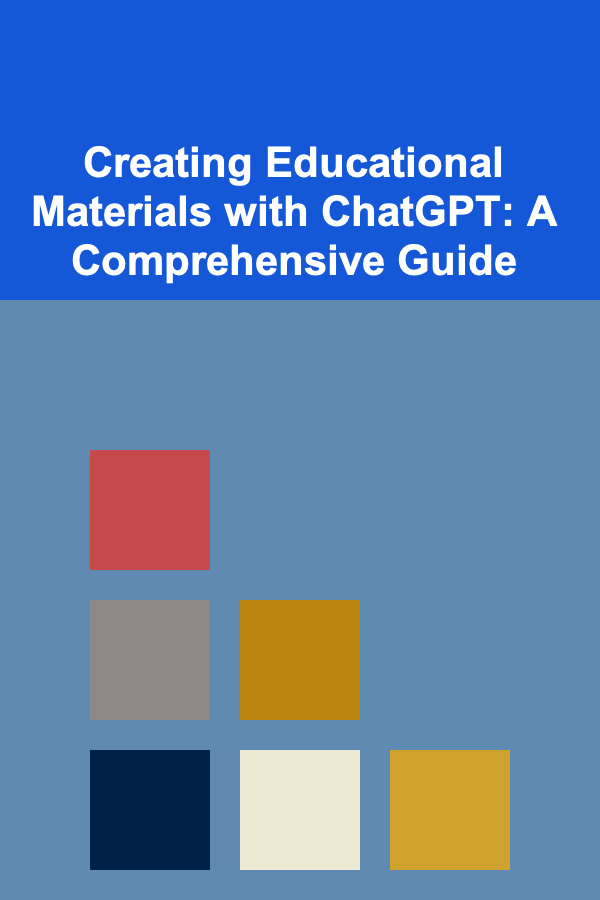
Creating Educational Materials with ChatGPT: A Comprehensive Guide
ebook include PDF & Audio bundle (Micro Guide)
$12.99$11.99
Limited Time Offer! Order within the next:

ChatGPT, a large language model developed by OpenAI, has emerged as a powerful tool for educators and instructional designers. Its ability to generate human-quality text, translate languages, write different kinds of creative content, and answer your questions in an informative way makes it an invaluable asset in the creation of diverse and engaging educational materials. This article provides a comprehensive guide on how to effectively leverage ChatGPT to enhance teaching and learning.
Understanding ChatGPT's Capabilities for Education
Before diving into specific applications, it's crucial to understand the range of capabilities ChatGPT offers for educational purposes.
- Content Generation: ChatGPT can generate various types of educational content, including lesson plans, quizzes, summaries, explanations, and even creative writing pieces.
- Personalized Learning: It can adapt content to different learning styles and levels of understanding. For example, it can simplify complex concepts for younger learners or provide more in-depth explanations for advanced students.
- Interactive Learning: ChatGPT can facilitate interactive learning experiences through chatbot interactions, simulations, and role-playing scenarios.
- Assessment: It can create assessments, provide feedback on student work, and even grade certain types of assignments (with human oversight, of course).
- Language Translation: ChatGPT can translate educational materials into multiple languages, making education more accessible to diverse learners.
- Idea Generation: When facing a creative block, ChatGPT can help brainstorm new ideas for lessons, activities, and projects.
However, it's important to acknowledge the limitations of ChatGPT:
- Accuracy: While ChatGPT is generally accurate, it can sometimes produce incorrect or misleading information. It's crucial to always verify the information it provides.
- Bias: ChatGPT can reflect biases present in the data it was trained on. It's important to be aware of this potential bias and to critically evaluate the content it generates.
- Lack of Contextual Understanding: ChatGPT may not always understand the specific context of a particular educational setting or the needs of individual students.
- Ethical Considerations: Over-reliance on ChatGPT can hinder the development of critical thinking and problem-solving skills in students. It's important to use ChatGPT as a tool to supplement, not replace, human instruction.
Crafting Effective Prompts for Educational Content
The quality of the output generated by ChatGPT depends heavily on the quality of the input prompt. Here are some tips for crafting effective prompts for educational materials:
- Be Specific: Clearly specify the topic, learning objectives, target audience, and desired format of the content.
- Provide Context: Provide relevant background information and context to help ChatGPT understand the specific needs of the learners.
- Use Keywords: Incorporate relevant keywords to guide ChatGPT's content generation.
- Define Tone and Style: Specify the desired tone and style of the content (e.g., formal, informal, engaging, humorous).
- Specify Length and Structure: Indicate the desired length of the content and the preferred structure (e.g., bullet points, numbered lists, paragraphs).
- Iterate and Refine: Don't be afraid to experiment with different prompts and refine your requests based on the output you receive.
Here are some examples of effective prompts:
Example 1: Creating a Lesson Plan
Prompt: "Create a lesson plan for a 9th-grade biology class on the topic of photosynthesis. The lesson should be designed for a 50-minute class period and should include a brief introduction, a lecture component, a hands-on activity, and a conclusion. The learning objectives are: (1) students will be able to define photosynthesis; (2) students will be able to explain the role of chlorophyll; and (3) students will be able to describe the process of photosynthesis in detail. Include suggested materials and assessment ideas."
Example 2: Generating Quiz Questions
Prompt: "Generate 10 multiple-choice quiz questions on the topic of the American Revolution for a high school history class. The questions should cover key events, figures, and concepts. Include the correct answer for each question. Ensure the questions are challenging but fair, testing understanding of the causes, major battles, and outcomes of the revolution."
Example 3: Summarizing a Complex Text
Prompt: "Summarize the following excerpt from Charles Darwin's On the Origin of Species in approximately 200 words, focusing on the concept of natural selection: [Insert excerpt here]."
Example 4: Creating a Creative Writing Prompt
Prompt: "Write a short story prompt for middle school students (grades 6-8) about a group of friends who discover a hidden portal to another world. The story should encourage creativity, problem-solving, and teamwork. The portal only opens when they solve a riddle."
Specific Applications of ChatGPT in Education
ChatGPT can be used in a wide variety of educational settings and for a wide range of purposes. Here are some specific applications:
1. Lesson Planning and Curriculum Development
ChatGPT can assist educators in creating comprehensive lesson plans, designing engaging learning activities, and aligning curriculum with learning standards. Instead of starting from scratch, teachers can use ChatGPT to build a framework that they then customize to their specific classroom needs.
Example Prompt: "Develop a 3-day unit plan for teaching fractions to 5th-grade students. The unit should cover adding fractions, subtracting fractions, and comparing fractions. Include specific learning objectives for each day, along with suggested activities, assessments, and resources. Also, suggest differentiation strategies for students who are struggling and students who are advanced."
2. Generating Explanations and Summaries
ChatGPT can simplify complex concepts and provide clear, concise explanations. This is particularly useful for students who are struggling to understand a particular topic or for teachers who need to explain a concept in a different way.
Example Prompt: "Explain the concept of supply and demand in economics in simple terms that a high school student can understand. Use examples to illustrate the relationship between supply, demand, and price."
ChatGPT can also create summaries of long texts, making it easier for students to grasp the main ideas.
Example Prompt: "Summarize the key findings of the Stanford Prison Experiment in approximately 150 words."
3. Creating Quizzes and Assessments
ChatGPT can generate various types of assessments, including multiple-choice questions, short-answer questions, and essay prompts. This can save teachers valuable time and effort in creating assessments.
Example Prompt: "Generate 15 true/false questions about the solar system for a middle school science class. Include the correct answer for each question."
Furthermore, ChatGPT can provide feedback on student work, helping students to identify areas for improvement.
Example Prompt: "Provide constructive feedback on the following student essay about the causes of World War I: [Insert essay here]. Focus on areas such as thesis statement, supporting arguments, evidence, and organization." Note that the quality of the feedback will depend heavily on the quality of the essay provided. This application requires careful review by the instructor.
4. Facilitating Interactive Learning
ChatGPT can be used to create interactive learning experiences, such as chatbot simulations and role-playing scenarios. This can help students to engage with the material in a more active and meaningful way.
Example Prompt: "Create a chatbot simulation where students can interview historical figures from the American Civil War. The chatbot should provide historically accurate answers to student questions and should adapt its responses based on the student's prior knowledge. Include questions the chatbot should anticipate and prepare answers for, covering topics such as the causes of the war, key battles, and the perspectives of different sides."
5. Providing Personalized Learning Experiences
ChatGPT can adapt content to different learning styles and levels of understanding. For example, it can simplify complex concepts for younger learners or provide more in-depth explanations for advanced students.
Example Prompt: "Explain the concept of derivatives in calculus to a student who is struggling with the basic concepts. Use visual aids and real-world examples to help the student understand the concept."
It can also generate different versions of the same content, catering to different learning preferences (e.g., auditory, visual, kinesthetic).
Example Prompt: "Create three different versions of a lesson on the Pythagorean theorem: one version that is primarily text-based, one version that is primarily visual, and one version that is primarily hands-on."
6. Supporting Language Learning
ChatGPT can translate educational materials into multiple languages, making education more accessible to diverse learners. It can also provide language practice and feedback to students who are learning a new language.
Example Prompt: "Translate the following English text about the importance of recycling into Spanish: [Insert text here]."
Example Prompt: "Create a conversation between two people in French about their favorite hobbies. The conversation should be approximately 10 sentences long and should use a variety of vocabulary and grammar structures."
7. Brainstorming and Idea Generation
When facing a creative block, ChatGPT can help brainstorm new ideas for lessons, activities, and projects.
Example Prompt: "Suggest five creative project ideas for a high school art class that focus on the theme of environmental sustainability."
8. Assisting with Research
While not a replacement for thorough research, ChatGPT can help to identify relevant sources and provide summaries of existing research on a particular topic. However, it's crucial to verify all information obtained from ChatGPT with reliable sources.
Example Prompt: "What are some of the key research findings on the effectiveness of blended learning in higher education?" Follow up by verifying the sources ChatGPT provides and consulting additional academic databases.
Best Practices for Using ChatGPT in Education
To maximize the effectiveness of ChatGPT in education, it's important to follow these best practices:
- Always Verify Information: Never rely solely on ChatGPT for factual information. Always cross-reference its output with reliable sources.
- Review and Edit Content: ChatGPT-generated content may require editing and refinement to ensure accuracy, clarity, and appropriateness for the target audience.
- Be Mindful of Bias: Be aware of the potential for bias in ChatGPT's output and critically evaluate the content it generates.
- Encourage Critical Thinking: Use ChatGPT as a tool to supplement, not replace, human instruction. Encourage students to think critically about the information they receive and to develop their own opinions.
- Promote Ethical Use: Educate students about the ethical implications of using AI tools like ChatGPT and emphasize the importance of academic integrity. Students should not submit ChatGPT-generated work as their own without proper attribution and critical engagement.
- Provide Clear Guidelines: Establish clear guidelines for students on how they are allowed to use ChatGPT in their coursework. This will help to prevent misuse and ensure that students are learning the material effectively.
- Experiment and Iterate: Don't be afraid to experiment with different prompts and approaches to find what works best for your students and your teaching style. The technology is constantly evolving, so continuous learning is essential.
- Focus on Higher-Order Thinking: Use ChatGPT to automate more mundane tasks, freeing up your time to focus on activities that promote higher-order thinking, such as problem-solving, critical analysis, and creative design.
- Consider Accessibility: Ensure that all students have equal access to ChatGPT and the necessary training to use it effectively. Address any potential digital divide issues.
Addressing Ethical Considerations
The use of ChatGPT in education raises several ethical considerations that need to be addressed:
- Plagiarism: Students may be tempted to use ChatGPT to generate assignments and submit them as their own work. Educators need to clearly define plagiarism and emphasize the importance of academic integrity.
- Equity: Not all students have equal access to technology or the internet. This could create a digital divide, where some students have an unfair advantage over others. Schools need to ensure that all students have equal access to technology and the internet.
- Dependence: Over-reliance on ChatGPT could hinder the development of critical thinking and problem-solving skills in students. Educators need to strike a balance between using ChatGPT as a tool and encouraging students to think for themselves.
- Privacy: ChatGPT collects data about its users. Educators need to be aware of the privacy implications of using ChatGPT and take steps to protect student privacy. Review OpenAI's data privacy policies.
- Bias: As mentioned earlier, ChatGPT can reflect biases present in the data it was trained on. Educators need to be aware of this potential bias and take steps to mitigate its effects. Encourage critical evaluation of all generated content.
To address these ethical considerations, educators should:
- Develop clear policies and guidelines for the use of ChatGPT in the classroom.
- Educate students about the ethical implications of using AI tools like ChatGPT.
- Promote critical thinking and problem-solving skills.
- Ensure that all students have equal access to technology and the internet.
- Take steps to protect student privacy.
- Continuously evaluate the impact of ChatGPT on student learning and adjust their teaching practices accordingly.
The Future of ChatGPT in Education
ChatGPT is still a relatively new technology, but it has the potential to revolutionize education. As the technology continues to develop, we can expect to see even more innovative applications of ChatGPT in the classroom. Some potential future applications include:
- AI-powered tutoring systems: Personalized tutoring systems that can adapt to the individual needs of each student.
- Automated grading and feedback: Automated systems that can grade assignments and provide feedback to students, freeing up teachers' time. This is still an area requiring substantial human oversight.
- Virtual field trips: Immersive virtual field trips that allow students to explore different places and cultures without leaving the classroom.
- AI-assisted lesson planning: Intelligent systems that can help teachers create more effective lesson plans and activities.
- Real-time language translation: Instant language translation that allows students from different countries to collaborate and learn together.
However, it is important to remember that ChatGPT is just a tool. It is up to educators to use it responsibly and ethically to enhance teaching and learning. By following the best practices outlined in this article, educators can leverage the power of ChatGPT to create more engaging, effective, and personalized learning experiences for all students.

Cost-Effective Ways for Saving Money on Home Internet Security Services
Read More
How to Create Eye-Catching T-Shirt Designs That Sell
Read More
How to Decorate Your Kitchen for the Holidays Without Clutter
Read More
How to Stage a Home with Pets: A Comprehensive Guide
Read More
How to Embrace a Plant-Based Diet Sustainably
Read More
10 Tips for Fermenting Vegetables at Home
Read MoreOther Products

Cost-Effective Ways for Saving Money on Home Internet Security Services
Read More
How to Create Eye-Catching T-Shirt Designs That Sell
Read More
How to Decorate Your Kitchen for the Holidays Without Clutter
Read More
How to Stage a Home with Pets: A Comprehensive Guide
Read More
How to Embrace a Plant-Based Diet Sustainably
Read More